Saint Stephen’s Cathedral in Vienna
By Tracy A. Burns
History
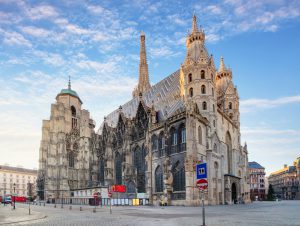 Dating back to Romanesque times, the most famous Viennese landmark marks the cityscape with its 137-meter high south tower and 230,000 colorful glazed roof tiles. During the 14th century, the cathedral got a Gothic makeover, and it was renovated with Baroque décor in the late 17th century. The triple-naved structure has taken a beating throughout history, damaged by more than 1,000 cannonballs courtesy of the Turks in the 17th century and then taking hits during the Napoleonic Wars from 1803 to 1815 and the Revolution of 1848 when reformers instigated unsuccessful political uprisings against the leadership. But the worst damage came in the 20th century. When it caught fire in April of 1945, about 45 percent of the architectural gem was destroyed but fortunately rebuilt. The Gothic roof truss, central nave, and glass windows were just a few of the casualties.
Dating back to Romanesque times, the most famous Viennese landmark marks the cityscape with its 137-meter high south tower and 230,000 colorful glazed roof tiles. During the 14th century, the cathedral got a Gothic makeover, and it was renovated with Baroque décor in the late 17th century. The triple-naved structure has taken a beating throughout history, damaged by more than 1,000 cannonballs courtesy of the Turks in the 17th century and then taking hits during the Napoleonic Wars from 1803 to 1815 and the Revolution of 1848 when reformers instigated unsuccessful political uprisings against the leadership. But the worst damage came in the 20th century. When it caught fire in April of 1945, about 45 percent of the architectural gem was destroyed but fortunately rebuilt. The Gothic roof truss, central nave, and glass windows were just a few of the casualties.
The exterior and Gothic portals
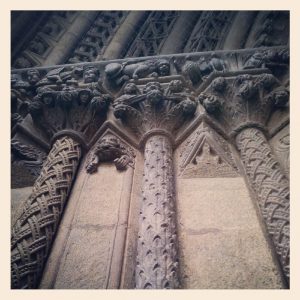 The exterior is breathtaking. The coat-of-arms of the Austrian Empire decorates the roof tiles, which create a zigzag pattern in 10 colors. Gargoyles spew water, defending the city against demons. The Gothic portals have richly detailed tympanums. For instance, the tympanum of the Singers’ Portal pictorially narrates scenes from the life of Saul from his journey to Damascus to his conversion as Apostle Paul. The Bishop’s Portal’s tympanum shows the Holy Mother dying, a candelabra, a grieving woman, and mourning apostles. Christ holds Mary’s crowned soul. The coronation of Mary is also depicted as angels making music. The tympanum on the main portal focuses on Christ giving a blessing on a rainbow. Reliefs on this portal are unique, showing a devil with a noose, a monster, winged sirens, entwined dragons, and two dogs sharing a head. Look for the dancing siren, who resembles a femme fatale.
The exterior is breathtaking. The coat-of-arms of the Austrian Empire decorates the roof tiles, which create a zigzag pattern in 10 colors. Gargoyles spew water, defending the city against demons. The Gothic portals have richly detailed tympanums. For instance, the tympanum of the Singers’ Portal pictorially narrates scenes from the life of Saul from his journey to Damascus to his conversion as Apostle Paul. The Bishop’s Portal’s tympanum shows the Holy Mother dying, a candelabra, a grieving woman, and mourning apostles. Christ holds Mary’s crowned soul. The coronation of Mary is also depicted as angels making music. The tympanum on the main portal focuses on Christ giving a blessing on a rainbow. Reliefs on this portal are unique, showing a devil with a noose, a monster, winged sirens, entwined dragons, and two dogs sharing a head. Look for the dancing siren, who resembles a femme fatale.
The pillar statues and high altar
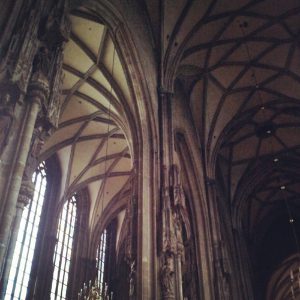 The cathedral is 107.2 meters long. Inside, statues of saints grace the three naves, helping to recount the story of the life and death of Jesus and the saints. The high altar is a highlight of the cathedral, the first and most prominent Early Baroque altar in the city. The altarpiece directs visitors’ gazes to heaven, depicted above a scene of Saint Stephen being stoned to death. Saints Sebastian and Rochus, protectors against the plague, make appearances, too. Another painting depicts the Holy Mother as Queen of the apostles and saints. A statue of the Blessed Virgin decorates the top of the altar. Three stunning stained glass windows show Christ being crucified and Saint Stephen being stoned to death, among other scenes.
The cathedral is 107.2 meters long. Inside, statues of saints grace the three naves, helping to recount the story of the life and death of Jesus and the saints. The high altar is a highlight of the cathedral, the first and most prominent Early Baroque altar in the city. The altarpiece directs visitors’ gazes to heaven, depicted above a scene of Saint Stephen being stoned to death. Saints Sebastian and Rochus, protectors against the plague, make appearances, too. Another painting depicts the Holy Mother as Queen of the apostles and saints. A statue of the Blessed Virgin decorates the top of the altar. Three stunning stained glass windows show Christ being crucified and Saint Stephen being stoned to death, among other scenes.
The pulpit
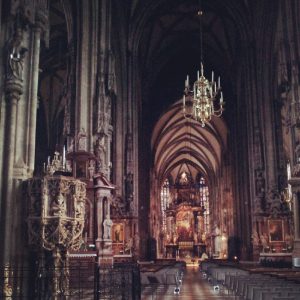 Hailing from the late 15th century, the pulpit is astounding for its Renaissance sculptural ornamentation. Four church doctors peer out from what looks like stone windows on the sandstone blocks, symbolizing the four ages of man and the four temperaments. The 12 Apostles and saints make prominent appearances, too. Look for a pensive Saint Augustine with a book, miter, and inkwell. Be sure to gaze under the steps: A self-portrait of the unknown sculptor peeks out at the viewer. Stone snakes and lizards as well as three-leafed and four-leafed wheels decorate the banister. The three-leafed wheels standing for the Holy Trinity point upwards while the four-leafed wheels representing the four seasons point downward. Frogs, snakes, lizards, and amphibians battle on the banister while a small dog protects the preacher from impending evil.
Hailing from the late 15th century, the pulpit is astounding for its Renaissance sculptural ornamentation. Four church doctors peer out from what looks like stone windows on the sandstone blocks, symbolizing the four ages of man and the four temperaments. The 12 Apostles and saints make prominent appearances, too. Look for a pensive Saint Augustine with a book, miter, and inkwell. Be sure to gaze under the steps: A self-portrait of the unknown sculptor peeks out at the viewer. Stone snakes and lizards as well as three-leafed and four-leafed wheels decorate the banister. The three-leafed wheels standing for the Holy Trinity point upwards while the four-leafed wheels representing the four seasons point downward. Frogs, snakes, lizards, and amphibians battle on the banister while a small dog protects the preacher from impending evil.
The Wiener Neustadt Altar and organ chancel
In the Women’s Nave, the four-winged Wiener Neustadt Altar from 1447 enchants, illustrating scenes from Mary’s life and the King adoring baby Jesus. Notice the beardless king. He stands for youth. The scene portraying the Holy Mother enthroned also features Saint Barbara, protector of firemen and against explosions, with a tower struck by lightning and Saint Catherine with the sword used in her martyrdom. When closed, the altar shows 72 saints taking up four rows. The head of sculptor Anton Pilgrim peeks out at visitors from the organ chancel. In the self-portrait, Pilgrim looks as if he has too many responsibilities and too much stress to handle.
“The Toothache Lord”
In the Apostles’ Nave, visitors find the Gothic Man of Sorrows, called “The Toothache Lord” due to a legend: Drunken partygoers were stumbling through Saint Stephen’s churchyard one night when they mocked the statue, claiming it looked like the Lord with a toothache. They even placed a cloth around its head. The inebriated were then struck with severe toothaches. They did not get better until they had repented in front of the statue.
The sepulcher, miracle painting, and baptismal font
Created by prominent sculptor Niclaes Gerhart van Leyden from 1463 to 1467, the sepulcher of Emperor Friedrich III honors the last emperor crowned by the Pope, who died in 1493. The three-level tomb boasts a balustrade with 54 figures of saints and apostles. The sins committed by the emperor are depicted as skulls and animals inspired by fantasy. Tears supposedly streamed down the Miracle Painting Maria Pócs, which refers to the Pócs village in northern Hungary, in 1696. The 15th-century baptismal font is the highlight of the Baptismal Chapel. The 14 niches at the basin show Christ as the savior, Saint Stephen, and the 12 apostles. Angels play drums and raise crosses above the seven reliefs of the seven sacraments.
Mozart and Saint Stephen’s Cathedral
Residing in Vienna most of his life, Wolfgang Amadeus Mozart had strong ties to this cathedral, which was the setting for his wedding to Constanze Weber on August 4, 1782. Two of his children were baptized in the baptistery. Mozart also was a regular at mass here. Although the 35-year-old was buried in a mass grave in 1791, a funeral service took place at Saint Stephen’s in the Prince Eugene of Savoy Chapel, named after one of the foremost military leaders serving Austria. At the service, Mozart’s famous Requiem resounded throughout the elegant space. A plaque commemorating Mozart also adorns a wall.
The catacombs and other spaces
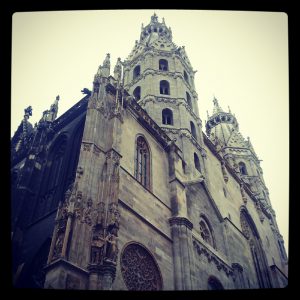 What is under the cathedral is intriguing, too. Catacombs house the Ducal Vault with the sarcophagus of Emperor Rudolf IV and 14 other tombs. Burial vaults under the building contain the brains, eyes, and intestines of 72 Habsburg rulers while the newer section of the catacombs, from 1744, is home to the remains of almost 11,000 people. Back above ground, the sacristies boast stunning frescoes and a large Gothic crucifix while the Treasure Room holds valuable vestments and liturgical items.
What is under the cathedral is intriguing, too. Catacombs house the Ducal Vault with the sarcophagus of Emperor Rudolf IV and 14 other tombs. Burial vaults under the building contain the brains, eyes, and intestines of 72 Habsburg rulers while the newer section of the catacombs, from 1744, is home to the remains of almost 11,000 people. Back above ground, the sacristies boast stunning frescoes and a large Gothic crucifix while the Treasure Room holds valuable vestments and liturgical items.




